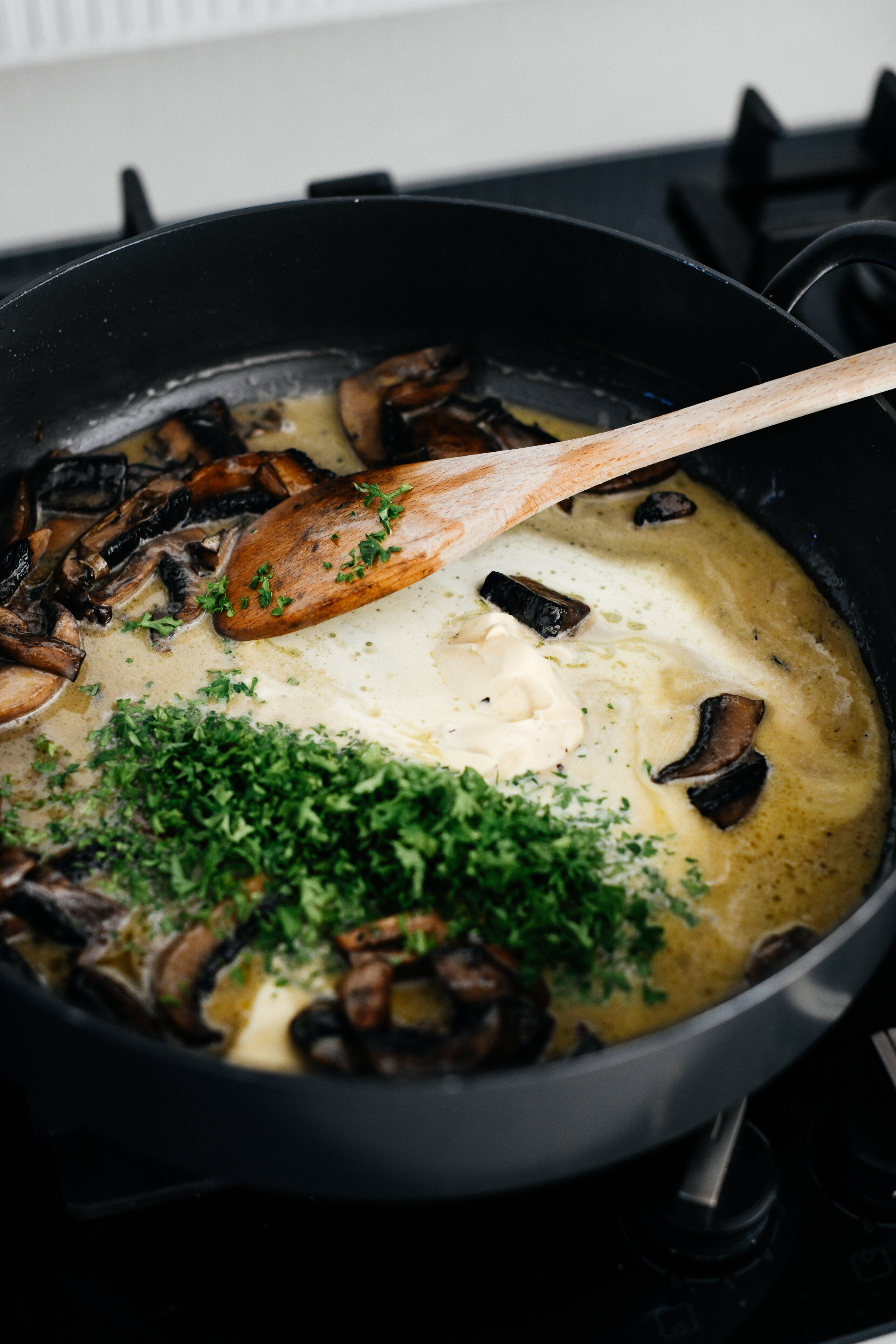Chive Funghetti ai Funghi
I first stumbled across this shape via Flour + Water and was immediately drawn to making it because I had never seen or heard of it before. I have since struggled to find much reference to funghetti at all, aside from a few low-res images of an extruded soup pasta called funghini, which as the diminutive -ini suggests is a smaller variety. I even scoured the Encyclopedia of Pasta for even a snippet of info, but to no avail. So all I can really tell you about this shape is that it resembles a mushroom, hence its name, and that it’s kind of related to sorpresine (little surprises), a shape that looks like tortellini at a glance but is in fact void of any filling (surprise!). Funghetti has a similar shaping technique to cappelletti, where a circular piece of dough is folded to into a semi circle, then each point pinched together to seal. Same same, different - you get it.
This recipe uses a fancy but surprisingly straight forward technique of laminating the dough with fresh herbs, but you can skip this step all together if you CBA. The main glory of this dish is to be found in the crevices of the funghetti, where the creamy, garlicky mushroom sauce gets caught up - bliss.
Chive Funghetti ai Funghi
Serves 2
Ingredients
For the pasta
250g tipo 00 flour
130g eggs (approx 2x large whole eggs and 1x egg yolk)
10ml extra virgin olive oil
1x bunch of fresh chives
For the mushroom sauce
2 tbsp extra virgin olive oil
3-4 Portobello mushrooms, roughly chopped - I quite like to cut a few different sizes of chunks for different texture
2 garlic cloves, minced
45g unsalted butter
100ml double cream
1 handful of finely chopped curly leaf parsley
1 large handful of grated Parmigiano Reggiano
Method
For the pasta
Place the flour in a mound on your work surface and make a well in the centre.
Add the eggs and olive oil, then begin to whisk until you have a thick custard-like consistency, incorporating a little bit of flour at a time as you do.
Switch to a bench scraper and start to flip the flour from the outer edge over and onto the eggs, using a cutting motion to then mix it in. Continue to do this around all sides until you have a shaggy dough.
Begin kneading the dough vigorously for a good 10 minutes until the dough is springy and elastic, and not sticking to your hands at all
Cover and rest at room temperature for 30 minutes before rolling.
Shaping the funghetti
Divide the dough into four pieces. Work with one at a time (keep the rest covered) - flatten the piece with your hand or a rolling pin before passing it through the thickest setting on your pasta machine. Fold the edges in to create a neat rectangle that fits the width of your pasta machine, and run it through the thickest setting again and again until your dough is uniform in shape.
Continue passing your dough through the machine, working through each thickness setting until it’s 1/16” thick, typically the third to last setting on most machines (setting 6 on a Marcato).
Lay your rolled sheet out and cut it in half to create two even sheets. Arrange the fresh chives on one of the sheets (I went for vertical lines), then take the other sheet of pasta and carefully place it over the top - creating a pasta sandwich, if you will.
Use a rolling pin to roughly press the two sheets of dough together, then trim the edges to remove any overhanging chive. Return to your pasta machine and pass the dough through one setting thicker than what you finished with before (setting 5 on a Marcato), and then again through the final desired setting (setting 6 on a Marcato).
Now you have laminated your pasta sheet with chives, it’s time to shape the funghetti. Using a 3 inch circle cutter, cut the sheet into circles. Save any scraps as maltagliati.
Holding one circle in front of you, fold the left side over to the right to form a semi-circle but don’t press to seal, then take the north and south edge of the side you folded over and pinch these together to seal, leaving a small teardrop opening
Continue with the rest of your dough, placing the formed funghetti on a baking sheet lined with a clean tea towel or dusted with fine semolina.
For the sauce
Bring a large pot of generously salted water to boil.
Heat olive oil in a large frying pan on a medium heat. Once hot add the mushrooms and sauté until they start to soften.
Add the minced garlic and allow the mushrooms and garlic to gently cook away for a few minutes - seasoning with a big pinch of salt.
Add the butter, cream and shortly after the parsley. Check seasoning, then reduce the heat to the lowest flame/setting and let it barely bubble away.
At this point your water should be boiling, so it’s time to cook the funghetti. Allow them to cook for 2 minutes or so before scooping out of the water with a slotted spoon or wire skimmer, and adding them directly to the mushroom sauce.
Sprinkle a handful of parmigiano on top and allow it to melt for a minute before tossing the pasta, parmigiano and sauce together.
Divide between two bowls and serve with a crack of black pepper, extra parmigiano and chopped parsley.





